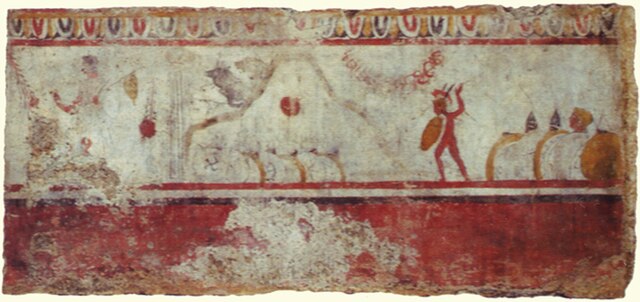Battle of the Caudine Forks
The Battle of Caudine Forks, 321 BC, was a decisive event of the Second Samnite War. Its designation as a battle is a mere historical formality: there was no fighting and there were no casualties. The Romans were trapped in an enclosed valley by the Samnites before they knew what was happening and nothing remained but to negotiate an unfavorable surrender. The action was entirely political, with the magistrates on both sides trying to obtain the best terms for their side without disrespecting common beliefs concerning the rules of war and the conduct of peace. In the end the Samnites decided it would be better for future relations to let the Romans go, while the Romans were impeded in the prosecution of their campaign against the Samnites by considerations of religion and honor.
A Lucanian painting (fresco) of the Battle of the Caudine Forks.
Medallion depicting the Romans being sent under the yoke by the Samnites (Pseudo-Melioli, c. 1500)
Second Samnite War, Battle of the Caudine Forks in 321 BC, the Roman army of the consuls Tiberius Veturius Calvinus symbolically pass under the yoke after their surrender.
The First, Second, and Third Samnite Wars were fought between the Roman Republic and the Samnites, who lived on a stretch of the Apennine Mountains south of Rome and north of the Lucanian tribe.The first of these wars was the result of Rome's intervention to rescue the Campanian city of Capua from a Samnite attack.
The second one was the result of Rome's intervention in the politics of the city of Naples and developed into a contest over the control of central and southern Italy.
Similarly the third war also involved a struggle for control of this part of Italy.
Samnite soldiers from a tomb frieze in Nola, 4th century BC
Ancient Roman fresco from the Esquiline Necropolis, dated c. 300–280 BC, possibly representing scenes from the Second Samnite war
A ceremonial Attic helmet typical of many found in Samnite tombs, c. 300 BC
Second Samnite War, Battle of the Caudine Forks in 321 BC, the Roman army of the consuls Tiberius Veturius Calvinus symbolically pass under the yoke after their surrender






